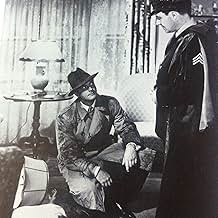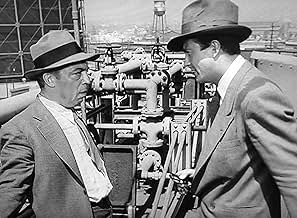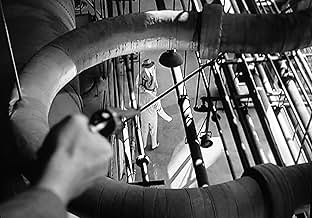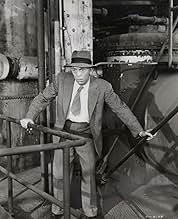VALUTAZIONE IMDb
6,5/10
2123
LA TUA VALUTAZIONE
Un poliziotto ossessionato rintraccia un serial killer sfuggente che strangola le sue vittime nelle notti di pioggia.Un poliziotto ossessionato rintraccia un serial killer sfuggente che strangola le sue vittime nelle notti di pioggia.Un poliziotto ossessionato rintraccia un serial killer sfuggente che strangola le sue vittime nelle notti di pioggia.
- Regia
- Sceneggiatura
- Star
Archie Twitchell
- Dixon
- (as Michael Branden)
Fred Aldrich
- Detective at Briefing
- (non citato nei titoli originali)
Walden Boyle
- Intern
- (non citato nei titoli originali)
Paul Bryar
- Sgt. Bryce
- (non citato nei titoli originali)
Wanda Cantlon
- Waitress
- (non citato nei titoli originali)
Maurice Cass
- Bookstore Owner
- (non citato nei titoli originali)
Martin Cichy
- Cop
- (non citato nei titoli originali)
Art Dupuis
- Detective
- (non citato nei titoli originali)
Recensioni in evidenza
Interesting B movie starring William Lundigan and Dorothy Patrick about a police detective's search for a serial killer called "The Judge."
Gritty city scenes (although as one poster points out, it was probably an RKO set) enhance the atmosphere, and it's one of the things that makes "Follow Me Quietly" unusual.
Two more items of interest: A very exciting finale and the twist of having the police make a dummy model from everything they know about the perpetrator. In one scene, Lundigan is talking to the dummy's back, and it turns out to actually be the killer.
Lundigan was a good looking, poor man's Joel McCrea, perfect to be a detective in real life but not much of an actor. He doesn't exude much energy. Patrick, an attractive blonde, neither wildly glamorous or beautiful, gives a spirited performance as a tabloid reporter.
Gritty city scenes (although as one poster points out, it was probably an RKO set) enhance the atmosphere, and it's one of the things that makes "Follow Me Quietly" unusual.
Two more items of interest: A very exciting finale and the twist of having the police make a dummy model from everything they know about the perpetrator. In one scene, Lundigan is talking to the dummy's back, and it turns out to actually be the killer.
Lundigan was a good looking, poor man's Joel McCrea, perfect to be a detective in real life but not much of an actor. He doesn't exude much energy. Patrick, an attractive blonde, neither wildly glamorous or beautiful, gives a spirited performance as a tabloid reporter.
Follow Me Quietly is directed by Richard Fleischer (with uncredited help from Anthony Mann) and adapted to screenplay by Lillie Hayward from a story written by Mann and Francis Rosenwald. It stars William Lundigan, Dorothy Patrick, Jeff Corey, Nestor Paiva and Paul Guilfoyle. Music is by Leonid Raab and cinematography by Robert De Grasse.
A serial killer known as "The Judge" is stalking the city, his modus operandi is to strike when it rains and to kill by strangulation. The police have loads of little clues but nothing solid to go on. The strain is starting to weigh heavy on Lt. Harry Grant (Lundigan), but he comes up with a genius idea to help catch the killer - a mannequin!
Not widely known, but once released to MOD home format it got more noticed and has been keenly sought out by fans of the great Anthony Mann. It has proved a little divisive so this fawning review should be taken with a little context. Clocking in at just under an hour in length, Fleischer's film is by definition a compact RKO "B" picture, but the quality of story, and the little slices of noir craft, ensure it's got plenty of strengths going for it.
In essence it's an early police procedural dealing with the hunt for a serial killer. There's a babe in the mix, Dorothy Patrick as an intrepid reporter who announcers herself to the film wearing a see through mackintosh, which of course is splendid. She teams up with Grant, not as a fatale, but as a sort of wry cohort, suggestion is evident, sexual tension even, but nothing is shoe-horned in to the pic. The cops are all stoic types, splendidly attired for period delights, but it's with Lundigan's head of investigations where the film gets its pulse beat. He gets in deep with the psychological aspects of the case, thinking like the killer, talking to the faceless mannequin that has been constructed out of clues left by the killer, the mirror images of the killer and mannequin are not exactly a million miles away from Lundigan himself. Cheeky is that.
Mann's stamp is all over the film, but Fleischer's work is evident for sure, an economical purist meets the crafty auteur, a fine match. Robert De Grasse (The Body Snatcher/Born to Kill) is a key component, operating with angles and shades when required, there's a distinct uneasy feel to proceedings. A few scenes grab the attention with full effect, akin to a spider inviting a fly to dinner, which all builds to a head, culminating in a blunderbuss finale at an oil refinery - cum - power plant. Only where White Heat (also 1949) went nighttime for its coup de grace, Follow Me Quietly did it in daylight. Cheeky is that.
It's not perfect. Some logic holes are there as regards the water effect with the killer, which also leads us to lament a lack of reasoning and understanding with the perpetrator. There's also a couple of instances where the mannequin is played in a rear shot by a real actor, why? I have no idea. While the best scene in the film, as Lundigan chats to the dummy in a darkened room - and the rain falls hard on the windows - brings about a reveal that makes no sense what so ever. Especially once "The Judge" is revealed. However, this is easy to recommend to noir heads and fans of police procedurals, and I loved it. 8/10
A serial killer known as "The Judge" is stalking the city, his modus operandi is to strike when it rains and to kill by strangulation. The police have loads of little clues but nothing solid to go on. The strain is starting to weigh heavy on Lt. Harry Grant (Lundigan), but he comes up with a genius idea to help catch the killer - a mannequin!
Not widely known, but once released to MOD home format it got more noticed and has been keenly sought out by fans of the great Anthony Mann. It has proved a little divisive so this fawning review should be taken with a little context. Clocking in at just under an hour in length, Fleischer's film is by definition a compact RKO "B" picture, but the quality of story, and the little slices of noir craft, ensure it's got plenty of strengths going for it.
In essence it's an early police procedural dealing with the hunt for a serial killer. There's a babe in the mix, Dorothy Patrick as an intrepid reporter who announcers herself to the film wearing a see through mackintosh, which of course is splendid. She teams up with Grant, not as a fatale, but as a sort of wry cohort, suggestion is evident, sexual tension even, but nothing is shoe-horned in to the pic. The cops are all stoic types, splendidly attired for period delights, but it's with Lundigan's head of investigations where the film gets its pulse beat. He gets in deep with the psychological aspects of the case, thinking like the killer, talking to the faceless mannequin that has been constructed out of clues left by the killer, the mirror images of the killer and mannequin are not exactly a million miles away from Lundigan himself. Cheeky is that.
Mann's stamp is all over the film, but Fleischer's work is evident for sure, an economical purist meets the crafty auteur, a fine match. Robert De Grasse (The Body Snatcher/Born to Kill) is a key component, operating with angles and shades when required, there's a distinct uneasy feel to proceedings. A few scenes grab the attention with full effect, akin to a spider inviting a fly to dinner, which all builds to a head, culminating in a blunderbuss finale at an oil refinery - cum - power plant. Only where White Heat (also 1949) went nighttime for its coup de grace, Follow Me Quietly did it in daylight. Cheeky is that.
It's not perfect. Some logic holes are there as regards the water effect with the killer, which also leads us to lament a lack of reasoning and understanding with the perpetrator. There's also a couple of instances where the mannequin is played in a rear shot by a real actor, why? I have no idea. While the best scene in the film, as Lundigan chats to the dummy in a darkened room - and the rain falls hard on the windows - brings about a reveal that makes no sense what so ever. Especially once "The Judge" is revealed. However, this is easy to recommend to noir heads and fans of police procedurals, and I loved it. 8/10
It's been a long time since I last saw Richard Fleischer's "Follow Me Quietly" on TV with commercial breaks making it seem longer than its 60 minute running time.
Looking at it again last week via a Warner Archive DVD that sure looks a lot better than the copy I saw years ago, my first reaction was one of "style over substance" but that's hardly a knock, and actually common for me when it comes to noir. This is really a programmer showing the talent of a director with aspirations, or as Fleischer claimed "This is the film that, above all, increased my knowledge of the trade. I learned how to organize a film." One can see that he was handed a script that is fairly routine, despite Anthony Mann sharing the credit for story. But Fleischer manages to add a few touches here and there to make an impression. The bit in policeman William Lundigan's apartment with the female reporter trying to get some story leads is quite suggestive although the two don't even so much as get into a clinch.
Lundigan, along with partner Jeff Corey, are on the trail of a serial killer known only as "The Judge" and in piling up what few clues they have, they manage to create a dummy that is the killer's size and appropriately dressed based on thread samples found - it's just missing a face. One eerie segment has Lundigan talking to the dummy until Corey walks in and warns him that he's bordering on being as crazy as the killer. But the scene doesn't end there however you'll have to watch it without my spoilers. I will say that here Fleischer does demonstrate his awareness that a film can be more than the sum of its parts.
However that point is teased several times in the film - that Lundigan and the killer may be of the same ilk. Lundigan is so unhinged perhaps to even allow a suspect who is confessing to demonstrate the method of strangulation that he used on a victim. Douglas Spencer makes good use of his minimal screen time in this segment. Even a waitress comments on a pattern of behavior that the cop shares with the criminal.
As Howard Hawks has said, a good film should have three good scenes and no boring scenes. In that respect, Fleischer doesn't let us down, even if a few scenes are the clichéd montage bits of cops pursuing leads, interviewing and pounding the pavement. You have to move the action forward somehow, even in a film that runs only an hour.
There's a mix of location shots (especially good in the finale) and studio sets to represent what we can presume to be Los Angeles. I'm just about certain that "The Judge" lived on the same block that Peter Lorre terrorized in "Stranger on the Third Floor." Dorothy Patrick plays the plucky reporter, she's quite appealing and manages to stay out of the way when told and thus avoiding the need for the cop to rescue the clueless female. In fact she's quite helpful when Lundigan gets a new lead and it's he who struck me as clueless on this point. Jeff Corey shines as Lundigan's partner and walks away with the film with ease.
Looking at it again last week via a Warner Archive DVD that sure looks a lot better than the copy I saw years ago, my first reaction was one of "style over substance" but that's hardly a knock, and actually common for me when it comes to noir. This is really a programmer showing the talent of a director with aspirations, or as Fleischer claimed "This is the film that, above all, increased my knowledge of the trade. I learned how to organize a film." One can see that he was handed a script that is fairly routine, despite Anthony Mann sharing the credit for story. But Fleischer manages to add a few touches here and there to make an impression. The bit in policeman William Lundigan's apartment with the female reporter trying to get some story leads is quite suggestive although the two don't even so much as get into a clinch.
Lundigan, along with partner Jeff Corey, are on the trail of a serial killer known only as "The Judge" and in piling up what few clues they have, they manage to create a dummy that is the killer's size and appropriately dressed based on thread samples found - it's just missing a face. One eerie segment has Lundigan talking to the dummy until Corey walks in and warns him that he's bordering on being as crazy as the killer. But the scene doesn't end there however you'll have to watch it without my spoilers. I will say that here Fleischer does demonstrate his awareness that a film can be more than the sum of its parts.
However that point is teased several times in the film - that Lundigan and the killer may be of the same ilk. Lundigan is so unhinged perhaps to even allow a suspect who is confessing to demonstrate the method of strangulation that he used on a victim. Douglas Spencer makes good use of his minimal screen time in this segment. Even a waitress comments on a pattern of behavior that the cop shares with the criminal.
As Howard Hawks has said, a good film should have three good scenes and no boring scenes. In that respect, Fleischer doesn't let us down, even if a few scenes are the clichéd montage bits of cops pursuing leads, interviewing and pounding the pavement. You have to move the action forward somehow, even in a film that runs only an hour.
There's a mix of location shots (especially good in the finale) and studio sets to represent what we can presume to be Los Angeles. I'm just about certain that "The Judge" lived on the same block that Peter Lorre terrorized in "Stranger on the Third Floor." Dorothy Patrick plays the plucky reporter, she's quite appealing and manages to stay out of the way when told and thus avoiding the need for the cop to rescue the clueless female. In fact she's quite helpful when Lundigan gets a new lead and it's he who struck me as clueless on this point. Jeff Corey shines as Lundigan's partner and walks away with the film with ease.
Normally lightweight William Lundigan is quite good as the hero cop of this quickie programmer. The rest of the cast is also quite good and the suspense remains high throughout. The plot is deceptively simple which is what makes the whole thing work in this atmospheric thriller. The only disappointment you'll have is that it's over so quickly.
I've been on a film noir fix lately & finding these flicks on You Tube such as Private Hell 36, Crime Of Passion, The Killer Is Loose, Please Murder Me, Raw Deal, Black Angel etc. Most of these I enjoyed & I've watched them once but when I stumbled onto this one yesterday I watched it again today as it was a little more than what I expected. Follow Me Quietly is not really a film noir it's a crime drama & police procedural.
It's a bit experimental & unusual which makes it stand out from the others, the late 40's post war period was a time when filmmakers were trying out new gimmicks such as subjective first person camera like Lady In The Lake (1946) & Dark Passage (1947). The police create a dummy of the killer from what evidence & clues they have which is a little more than the usual routine bulletin description of a suspect.
Sometimes a person can be identified & recognized by the back of their head & ears & the size & shape of their body & physique. Since the police have never seen the killers face the dummy is faceless & startling. The scene where the killer replaces the dummy & sits in William Lundigan's office facing the window with it's back to him is clever but pointless & foolish. What if the detective was smart enough to notice it was really him ? Why would the killer take such a risk ? I think it was just a gimmick & for cinematic effect to satisfy the filmmakers & to give the audience a thrill. The silly trick worked & fooled me I thought it was the faceless dummy.
And when the killers face is revealed he's not what you expect, he's very insecure & nervous & seems incapable of doing anything right. How did he manage to kill 8 victims & get away with it ? The ending is similar to White Heat & this film isn't great but it's fun & interesting, different & memorable & worth watching. I've seen it twice & I may watch it again.
It's a bit experimental & unusual which makes it stand out from the others, the late 40's post war period was a time when filmmakers were trying out new gimmicks such as subjective first person camera like Lady In The Lake (1946) & Dark Passage (1947). The police create a dummy of the killer from what evidence & clues they have which is a little more than the usual routine bulletin description of a suspect.
Sometimes a person can be identified & recognized by the back of their head & ears & the size & shape of their body & physique. Since the police have never seen the killers face the dummy is faceless & startling. The scene where the killer replaces the dummy & sits in William Lundigan's office facing the window with it's back to him is clever but pointless & foolish. What if the detective was smart enough to notice it was really him ? Why would the killer take such a risk ? I think it was just a gimmick & for cinematic effect to satisfy the filmmakers & to give the audience a thrill. The silly trick worked & fooled me I thought it was the faceless dummy.
And when the killers face is revealed he's not what you expect, he's very insecure & nervous & seems incapable of doing anything right. How did he manage to kill 8 victims & get away with it ? The ending is similar to White Heat & this film isn't great but it's fun & interesting, different & memorable & worth watching. I've seen it twice & I may watch it again.
Lo sapevi?
- QuizFilmed in only sixteen days.
- BlooperWhen Detective Grant is in the office trying to solve the serial killings; he begins talking to the "Judge" dummy that is sitting on a chair with its back turned to him. After Collins interrupts him and they both leave the office; the dummy comes to life. It turns out that the real killer hid the dummy and took its place sitting on the chair. The puzzling thing is that the film does not explain how the killer manages to enter the Police precinct and the Detective's office without being detected. In addition, why would the killer want to go there and how did the killer in the first place even know the existence of a lookalike dummy. Finally, Detective Grant has been practically living with this dummy so it makes no sense that he couldn't tell even from the back that it was a real human being there. All these factors briefly interrupted the flow of the story.
- Citazioni
Lt. Harry Grant: Funny thing how he always strikes in the rain.
Sgt. Art Collins: Maybe he likes rain. Must be a fish.
- ConnessioniFeatured in Sterminate la gang! (1950)
I più visti
Accedi per valutare e creare un elenco di titoli salvati per ottenere consigli personalizzati
Dettagli
- Data di uscita
- Paese di origine
- Lingua
- Celebre anche come
- Seguimi in silenzio
- Luoghi delle riprese
- Azienda produttrice
- Vedi altri crediti dell’azienda su IMDbPro
- Tempo di esecuzione1 ora
- Colore
- Proporzioni
- 1.37 : 1
Contribuisci a questa pagina
Suggerisci una modifica o aggiungi i contenuti mancanti

Divario superiore
By what name was Follow Me Quietly (1949) officially released in India in English?
Rispondi


































